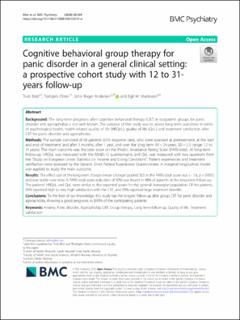| dc.contributor.author | Bilet, Truls | |
| dc.contributor.author | Olsen, Thorbjørn | |
| dc.contributor.author | Andersen, John Roger | |
| dc.contributor.author | Martinsen, Egil Wilhelm | |
| dc.coverage.spatial | Norway | en_US |
| dc.date.accessioned | 2020-10-05T07:48:47Z | |
| dc.date.available | 2020-10-05T07:48:47Z | |
| dc.date.created | 2020-08-05T11:43:03Z | |
| dc.date.issued | 2020 | |
| dc.identifier.citation | Bilet, T., Olsen, T., Andersen, J. R., & Martinsen, E. W. (2020). Cognitive behavioral group therapy for panic disorder in a general clinical setting: A prospective cohort study with 12 to 31-years follow-up. BMC Psychiatry, 20(1). | en_US |
| dc.identifier.issn | 1471-244X | |
| dc.identifier.uri | https://hdl.handle.net/11250/2681042 | |
| dc.description.abstract | Background
The long-term prognosis after cognitive behavioral therapy (CBT) in outpatient groups for panic disorder and agoraphobia is not well known. The purpose of this study was to assess long-term outcomes in terms of psychological health, health-related quality of life (HRQoL), quality of life (QoL) and treatment satisfaction after CBT for panic disorder and agoraphobia.
Methods
The sample consisted of 68 patients (61% response rate), who were assessed at pretreatment; at the start and end of treatment; and after 3 months, after 1 year, and over the long term (M = 24 years; SD = 5.3; range: 12 to 31 years). The main outcome was the total score on the Phobic Avoidance Rating Scale (PARS-total). At long-term follow-up, HRQoL was measured with the RAND-12 questionnaire, and QoL was measured with two questions from the “Study on European Union Statistics on Income and Living Conditions”. Patient experiences and treatment satisfaction were assessed by the Generic Short Patient Experiences Questionnaire. A marginal longitudinal model was applied to study the main outcome.
Results
The effect size of the long-term change (mean change/ pooled SD) in the PARS-total score was (− 1.6, p < 0.001) and was stable over time. A PARS-total score reduction of 50% was found in 98% of patients at the long-term follow-up. The patients’ HRQoL and QoL were similar to the expected scores for the general Norwegian population. Of the patients, 95% reported high to very high satisfaction with the CBT, and 93% reported large treatment benefits.
Conclusions
To the best of our knowledge, this study has the longest follow-up after group CBT for panic disorder and agoraphobia, showing a good prognosis in ≥93% of the participating patients. | en_US |
| dc.language.iso | eng | en_US |
| dc.publisher | BioMed Central | en_US |
| dc.rights | Navngivelse 4.0 Internasjonal | * |
| dc.rights.uri | http://creativecommons.org/licenses/by/4.0/deed.no | * |
| dc.subject | anxiety | en_US |
| dc.subject | panic disorder | en_US |
| dc.subject | agoraphobia | en_US |
| dc.subject | CBT | en_US |
| dc.subject | group therapy | en_US |
| dc.subject | long term follow-up | en_US |
| dc.subject | quality of life | en_US |
| dc.subject | treatment satisfaction | en_US |
| dc.title | Cognitive behavioral group therapy for panic disorder in a general clinical setting: A prospective cohort study with 12 to 31-years follow-up | en_US |
| dc.type | Peer reviewed | en_US |
| dc.type | Journal article | en_US |
| dc.description.version | publishedVersion | en_US |
| dc.rights.holder | © The Author(s) 2020 | en_US |
| dc.subject.nsi | VDP::Samfunnsvitenskap: 200::Psykologi: 260::Klinisk psykologi: 262 | en_US |
| dc.source.volume | 20 | en_US |
| dc.source.journal | BMC Psychiatry | en_US |
| dc.identifier.doi | 10.1186/s12888-020-02679-w | |
| dc.identifier.cristin | 1821745 | |
| cristin.ispublished | true | |
| cristin.fulltext | original | |
| cristin.qualitycode | 1 | |

